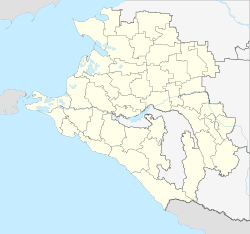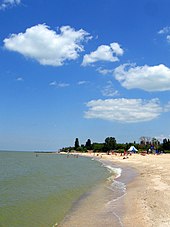Jeisk
| city
Yeisk
Ейск
|
||||||||||||||||||||||||||||||||||||||||||
|
||||||||||||||||||||||||||||||||||||||||||
|
||||||||||||||||||||||||||||||||||||||||||
| List of cities in Russia | ||||||||||||||||||||||||||||||||||||||||||
Jeisk , also Jejsk ( Russian Ейск ) is a Russian city with 87,769 inhabitants (as of October 14, 2010) in the Krasnodar region in the Federal District of Southern Russia .
Geography and climate
The city is located in the north of the Krasnodar Territory on the southern coast of the Taganrog Bay of the Sea of Azov . It is the administrative center of the raion of the same name and is located around 250 kilometers north of the regional capital Krasnodar and around 170 km southwest of the metropolis of Rostov-on-Don . The nearest town is Primorsko-Akhtarsk 72 km south of Yeisk.
Yeisk is an important health resort with sanatoriums, mud and sulfur springs and attracts tourists due to its location by the sea. The climate in the city is continental temperate , dry and extremely warm by Russian standards. The warmest month of the year is July with a daily average of 24 ° C; at this time the precipitation reaches its maximum with an average of 48 mm. Compared to northern Russian regions, the winter has little snow, but it is much colder and drier than in comparable European latitudes: the average temperature in January is -4 ° C and the amount of precipitation is 36 mm.
history
Yeisk was founded from the beginning with the aim of equipping the areas of the Kuban area , which were already relatively densely populated in the early 19th century, with their own seaport, in order to facilitate the supra-regional trade in abundant agricultural goods in this fertile region. The founding date of the city is August 31, 1848, when it was inaugurated after the completion of the port and received city rights right from the start.
Notwithstanding the fighting and considerable destruction during the Crimean War , Yeisk had developed into a major trading center of the Russian south by the end of the century, which brought prosperity to the city and a rapid development of infrastructure. In 1869 Yeisk was declared the center of the newly formed Ujesd of the Kuban Oblast . In the first years of the 20th century, Yeisk was fitted with a railway connection and the Yeisk seaport was given a general overhaul. From 1912, spa facilities and tourism developed in Yeisk with the development of the first thermal water springs .
In the early Soviet period , the city's development took several directions: On the one hand, new sanatoriums and spa houses were opened, which enabled Yeisk to consolidate its reputation as an important tourist center. On the other hand, the city's first industrial companies and, in the 1930s, a renowned military aviation school, whose well-known graduates later included the cosmonauts Juri Onufrijenko and Georgi Schonin and the test pilot Viktor Pugachev .
During the Second World War , the German Wehrmacht tried several times to take Yeisk from the opposite side of the bay, especially in winter by crossing the icy bay. In August 1942 the Wehrmacht finally succeeded in taking the city with the support of a Romanian division. The occupation lasted until February 1943, claimed casualties among the city's population and left a series of devastations.
In the post-war period, Yeisk was primarily rebuilt and developed as a spa town. With the economic decline of the 1990s, however, tourism in Yeisk rapidly lost its importance.
Population development
| year | Residents |
|---|---|
| 1897 | 35,414 |
| 1939 | 46,939 |
| 1959 | 55,324 |
| 1970 | 64,418 |
| 1979 | 70,595 |
| 1989 | 78,150 |
| 2002 | 86,349 |
| 2010 | 87,769 |
Note: census data
Economy and Transport
Fishing and its processing as well as the production of other foodstuffs are of industrial importance in Yeisk. The building materials and light industries are also represented to a lesser extent. A nationally known industrial company in Yeisk is the factory Attrakzion for the production of rides . The recreational system in Yeisk is still expandable and therefore has more of a regional significance.
With the port on the Sea of Azov, the city has an international sea freight terminal. There is a long-distance train station in the city with connections u. a. to Novorossiysk , Moscow and Saint Petersburg , as well as a small airport.
Further educational institutions
- Branch of the Moscow State Open University
- Branch of Taganrog State Radio Technical University
- Branch of the Krasnodar Military Institute of Air Force
Personalities
sons and daughters of the town
- Nina Castièl (* 1919), writer
- Tatiana Shchelkanova (1937–2011), long jumper
- Yevgeny Zymbal (* 1949), director
- Sergei Lazarew (* 1952), researcher, psychologist and writer
- Robert Stieglitz (* 1981), boxer
- Dmitri Ushakow (* 1988), trampoline gymnast
- Stefanija Jelfutina (* 1997), windsurfer
Personalities related to Yeisk
- Ivan Poddubny (1871–1949), Russian wrestler, six-time world champion; lived in Yeisk from 1927 to 1949
See also
Individual evidence
- ↑ a b Itogi Vserossijskoj perepisi naselenija 2010 goda. Tom 1. Čislennostʹ i razmeščenie naselenija (Results of the All-Russian Census 2010. Volume 1. Number and distribution of the population). Tables 5 , pp. 12-209; 11 , pp. 312–979 (download from the website of the Federal Service for State Statistics of the Russian Federation)
Web links
- Official website of the city (Russian)
- The Virtual Yeisk (Russian)
- Yeisk on mojgorod.ru (Russian)







